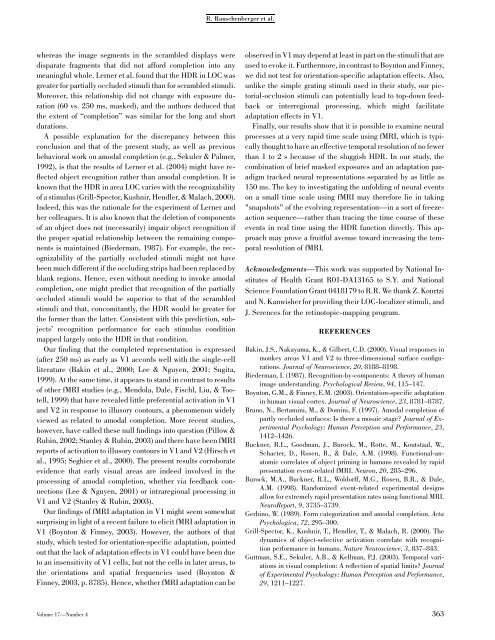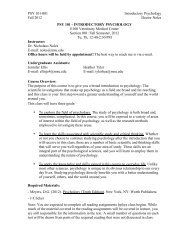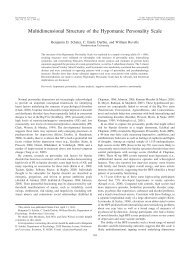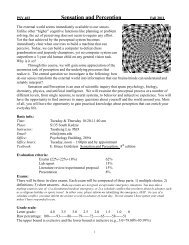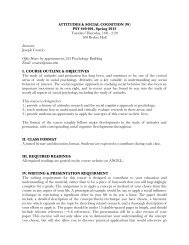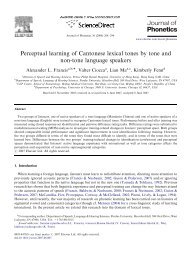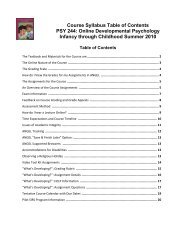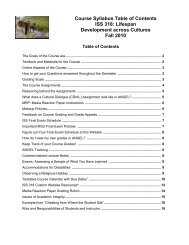Temporally Unfolding Neural Representation of Pictorial Occlusion
Temporally Unfolding Neural Representation of Pictorial Occlusion
Temporally Unfolding Neural Representation of Pictorial Occlusion
You also want an ePaper? Increase the reach of your titles
YUMPU automatically turns print PDFs into web optimized ePapers that Google loves.
R. Rauschenberger et al.whereas the image segments in the scrambled displays weredisparate fragments that did not afford completion into anymeaningful whole. Lerner et al. found that the HDR in LOC wasgreater for partially occluded stimuli than for scrambled stimuli.Moreover, this relationship did not change with exposure duration(60 vs. 250 ms, masked), and the authors deduced thatthe extent <strong>of</strong> ‘‘completion’’ was similar for the long and shortdurations.A possible explanation for the discrepancy between thisconclusion and that <strong>of</strong> the present study, as well as previousbehavioral work on amodal completion (e.g., Sekuler & Palmer,1992), is that the results <strong>of</strong> Lerner et al. (2004) might have reflectedobject recognition rather than amodal completion. It isknown that the HDR in area LOC varies with the recognizability<strong>of</strong> a stimulus (Grill-Spector, Kushnir, Hendler, & Malach, 2000).Indeed, this was the rationale for the experiment <strong>of</strong> Lerner andher colleagues. It is also known that the deletion <strong>of</strong> components<strong>of</strong> an object does not (necessarily) impair object recognition ifthe proper spatial relationship between the remaining componentsis maintained (Biederman, 1987). For example, the recognizability<strong>of</strong> the partially occluded stimuli might not havebeen much different if the occluding strips had been replaced byblank regions. Hence, even without needing to invoke amodalcompletion, one might predict that recognition <strong>of</strong> the partiallyoccluded stimuli would be superior to that <strong>of</strong> the scrambledstimuli and that, concomitantly, the HDR would be greater forthe former than the latter. Consistent with this prediction, subjects’recognition performance for each stimulus conditionmapped largely onto the HDR in that condition.Our finding that the completed representation is expressed(after 250 ms) as early as V1 accords well with the single-cellliterature (Bakin et al., 2000; Lee & Nguyen, 2001; Sugita,1999). At the same time, it appears to stand in contrast to results<strong>of</strong> other fMRI studies (e.g., Mendola, Dale, Fischl, Liu, & Tootell,1999) that have revealed little preferential activation in V1and V2 in response to illusory contours, a phenomenon widelyviewed as related to amodal completion. More recent studies,however, have called these null findings into question (Pillow &Rubin, 2002; Stanley & Rubin, 2003) and there have been fMRIreports <strong>of</strong> activation to illusory contours in V1 and V2 (Hirsch etal., 1995; Seghier et al., 2000). The present results corroborateevidence that early visual areas are indeed involved in theprocessing <strong>of</strong> amodal completion, whether via feedback connections(Lee & Nguyen, 2001) or intraregional processing inV1 and V2 (Stanley & Rubin, 2003).Our findings <strong>of</strong> fMRI adaptation in V1 might seem somewhatsurprising in light <strong>of</strong> a recent failure to elicit fMRI adaptation inV1 (Boynton & Finney, 2003). However, the authors <strong>of</strong> thatstudy, which tested for orientation-specific adaptation, pointedout that the lack <strong>of</strong> adaptation effects in V1 could have been dueto an insensitivity <strong>of</strong> V1 cells, but not the cells in later areas, tothe orientations and spatial frequencies used (Boynton &Finney, 2003, p. 8785). Hence, whether fMRI adaptation can beobserved in V1 may depend at least in part on the stimuli that areused to evoke it. Furthermore, in contrast to Boynton and Finney,we did not test for orientation-specific adaptation effects. Also,unlike the simple grating stimuli used in their study, our pictorial-occlusionstimuli can potentially lead to top-down feedbackor interregional processing, which might facilitateadaptation effects in V1.Finally, our results show that it is possible to examine neuralprocesses at a very rapid time scale using fMRI, which is typicallythought to have an effective temporal resolution <strong>of</strong> no fewerthan 1 to 2 s because <strong>of</strong> the sluggish HDR. In our study, thecombination <strong>of</strong> brief masked exposures and an adaptation paradigmtracked neural representations separated by as little as150 ms. The key to investigating the unfolding <strong>of</strong> neural eventson a small time scale using fMRI may therefore lie in taking"snapshots" <strong>of</strong> the evolving representation—in a sort <strong>of</strong> freezeactionsequence—rather than tracing the time course <strong>of</strong> theseevents in real time using the HDR function directly. This approachmay prove a fruitful avenue toward increasing the temporalresolution <strong>of</strong> fMRI.Acknowledgments—This work was supported by National Institutes<strong>of</strong> Health Grant R01-DA13165 to S.Y. and NationalScience Foundation Grant 0418179 to R.R. We thank Z. Kourtziand N. Kanwisher for providing their LOC-localizer stimuli, andJ. Serences for the retinotopic-mapping program.REFERENCESBakin, J.S., Nakayama, K., & Gilbert, C.D. (2000). Visual responses inmonkey areas V1 and V2 to three-dimensional surface configurations.Journal <strong>of</strong> Neuroscience, 20, 8188–8198.Biederman, I. (1987). Recognition-by-components: A theory <strong>of</strong> humanimage understanding. Psychological Review, 94, 115–147.Boynton, G.M., & Finney, E.M. (2003). Orientation-specific adaptationin human visual cortex. Journal <strong>of</strong> Neuroscience, 23, 8781–8787.Bruno, N., Bertamini, M., & Domini, F. (1997). Amodal completion <strong>of</strong>partly occluded surfaces: Is there a mosaic stage? Journal <strong>of</strong> ExperimentalPsychology: Human Perception and Performance, 23,1412–1426.Buckner, R.L., Goodman, J., Burock, M., Rotte, M., Koutstaal, W.,Schacter, D., Rosen, B., & Dale, A.M. (1998). Functional-anatomiccorrelates <strong>of</strong> object priming in humans revealed by rapidpresentation event-related fMRI. Neuron, 20, 285–296.Burock, M.A., Buckner, R.L., Woldorff, M.G., Rosen, B.R., & Dale,A.M. (1998). Randomized event-related experimental designsallow for extremely rapid presentation rates using functional MRI.NeuroReport, 9, 3735–3739.Gerbino, W. (1989). Form categorization and amodal completion. ActaPsychologica, 72, 295–300.Grill-Spector, K., Kushnir, T., Hendler, T., & Malach, R. (2000). Thedynamics <strong>of</strong> object-selective activation correlate with recognitionperformance in humans. Nature Neuroscience, 3, 837–843.Guttman, S.E., Sekuler, A.B., & Kellman, P.J. (2003). Temporal variationsin visual completion: A reflection <strong>of</strong> spatial limits? Journal<strong>of</strong> Experimental Psychology: Human Perception and Performance,29, 1211–1227.Volume 17—Number 4 363


